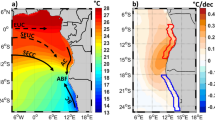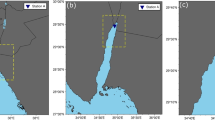Abstract
The fine structure of oxygen in some regions of the north-eastern Atlantic has been studied. A discrete-continuous inflow of the Mediterranean intermediate water has a strong effect on the O2 distribution in the layer of the main minimum of oxygen concentration. In general, this layer tends to increase and become more oxygenated when the mean vertical gradients of the oxygen concentration become smaller. Lenses of intrusion and inversion of the seawater with a high O2 content are observed in the layer. Passage of the lens in the layer of the main minimum of oxygen concentration induces vertical advection of waters and a decrease of the oxygen concentration above and below the lens within 500–700 m.
Similar content being viewed by others
References
Chemistry of the Ocean. 1. Chemistry of the Seawater. Moscow: Mir (1979), pp. 156–160.
Bubnov, V. A. Map** of the North Atlantic by peculiarities of origin and structure of oxygen minimum.Okeanol. Issled. (1971)21, 80–96.
Emelyanov, M. V. and Fyodorov, K. N. Structure and transformation of intermediate waters from the Mediterranean Sea and Atlantic Ocean.Okeanologia (1985)25, 206–214.
Belkin, I. M. and Kostyanoy, A. G. Mediterranean lenses in the North Atlantic.MEZOPOLYGON Hydrophysical Investigations. Moscow: Nauka (1988), pp. 110–122.
Plakhin, E. A. and Smirnov, V. P.Transformation of Mediterranean Intrusions with Range. Moscow: Nauka (1988), pp. 97–109.
Ovsyany, E. I. Hydrochemical investigations at the Portugese test area in the Atlantic Ocean in November 1987. Investigations of the vertical fine structure of the hydrophysical fields in the tropical and subtropical Atlantic areas. 49th cruise of the R/VMikhail Lomonosov. Dep. VINITI, No. 378-B89 (1989), pp. 133–143.
Rabinovich, M. E., Romanov, A. S., Ovsyany, E. I.,et al. Hydrophysical probes MGI-4102 and MGI-4103 with an oxygen channel: experience provided in the course ofin situ dissolved oxygen measurements. Dep. VINITI, No. 378-B89 (1989), pp. 144–145.
Smirnov, G. V., Lavrov, S. A., Rabinovich, M. E. and Vnukov, Yu. L. Measurements of the dissolved oxygen in seawater using an electrochemical technique.Morsk. Gidrofiz. Zh. (1985) No. 6, 49–53.
Ivanenkov, V. N. and Gusarova, A. N. Annual exchange of dissolved oxygen, silicic acid and non-organic dissolved phosphorus between the oceans.Khimya Morei i Okeanov. Moscow: Nauka (1973), pp. 5–17.
Additional information
Translated by V. Puchkin.
Rights and permissions
About this article
Cite this article
Bezborodov, A.A., Ovsyany, E.I. Influence of the Mediterranean intermediate waters on oxygen distribution in the Atlantic Ocean. Soviet Journal of Physical Oceanography 2, 321–328 (1991). https://doi.org/10.1007/BF02346084
Issue Date:
DOI: https://doi.org/10.1007/BF02346084




